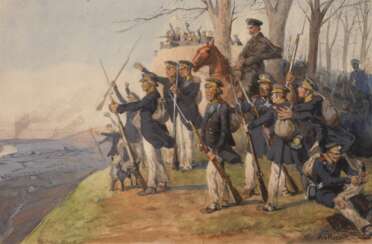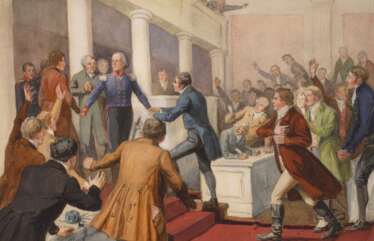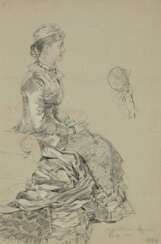anton von werner

Anton Alexander von Werner, a German painter, was celebrated for his historical paintings that captured key political and military events of Prussia. His works are notable for their depiction of significant moments such as the proclamation of the German Empire at the Hall of Mirrors, Versailles, in 1871. This particular painting marked a turning point in his career, earning him acclaim and establishing his reputation as a leading historical painter of his time.
Von Werner's art was deeply influenced by his experiences during the Franco-Prussian War, where he served in an unofficial capacity alongside the 3rd Army Corps. His firsthand observations of war and its leaders, such as Bismarck and Moltke, enriched his paintings with authenticity and emotional depth.
As the director of the Berlin Academy from 1875 until his death in 1915, Werner played a crucial role in shaping German art education and had the opportunity to tutor German Emperor William II in painting. His works, including commissioned pieces for the Victory Column and other public monuments in Berlin, often utilized innovative techniques such as stained glass mosaics.
For collectors and experts in art and antiques, Werner's paintings are significant not only for their artistic quality but also for their historical portrayal of the Wilhelmine Period in Germany. His works continue to be appreciated in exhibitions and collections globally.
To receive updates on new product sales and auction events related to Anton Alexander von Werner, you can sign up for our newsletter. This will ensure you remain informed about opportunities to acquire works by this pivotal figure in German art history.


Georg Johann Christian Urlaub or Egor Fedorovich Urlaub ((Russian: Егор Фёдорович Урлауб) was a Russian and German historical painter of Bavarian origin, academician of the Imperial Academy of Arts.
Georg was born into the family of the painter and enamelist Theodor Urlaub (1814-1888), a German native and Russian citizen who worked in St. Petersburg. He studied first at the Russian Academy of Arts, then in Berlin and Munich. After returning to Russia in 1880, Urlaub was appointed a member (academician) of the Imperial Academy of Arts in St. Petersburg. After some time he went to Paris and then settled in Munich.
Urlaub had a special love for historical themes and subjects, he also created portraits, genre and landscape paintings. He painted predominantly in an impressionistic and realistic style. Urlaub also illustrated various novels by Walter Scott.


Anton Alexander von Werner, a German painter, was celebrated for his historical paintings that captured key political and military events of Prussia. His works are notable for their depiction of significant moments such as the proclamation of the German Empire at the Hall of Mirrors, Versailles, in 1871. This particular painting marked a turning point in his career, earning him acclaim and establishing his reputation as a leading historical painter of his time.
Von Werner's art was deeply influenced by his experiences during the Franco-Prussian War, where he served in an unofficial capacity alongside the 3rd Army Corps. His firsthand observations of war and its leaders, such as Bismarck and Moltke, enriched his paintings with authenticity and emotional depth.
As the director of the Berlin Academy from 1875 until his death in 1915, Werner played a crucial role in shaping German art education and had the opportunity to tutor German Emperor William II in painting. His works, including commissioned pieces for the Victory Column and other public monuments in Berlin, often utilized innovative techniques such as stained glass mosaics.
For collectors and experts in art and antiques, Werner's paintings are significant not only for their artistic quality but also for their historical portrayal of the Wilhelmine Period in Germany. His works continue to be appreciated in exhibitions and collections globally.
To receive updates on new product sales and auction events related to Anton Alexander von Werner, you can sign up for our newsletter. This will ensure you remain informed about opportunities to acquire works by this pivotal figure in German art history.














































































